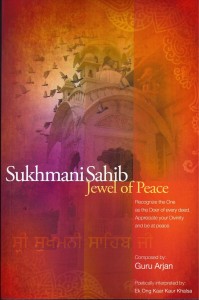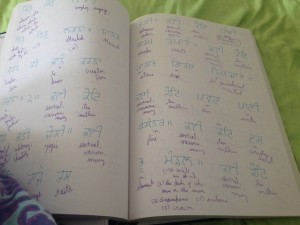 Grateful to present this latest publication – Sukhmani Sahib – The Jewel of Peace. Originally composed by the fifth Sikh Master, Guru Arjan, in the sacred language of Gurmukhi, this English poetic interpretation seeks to reflect the beauty and wisdom of the original work.
Grateful to present this latest publication – Sukhmani Sahib – The Jewel of Peace. Originally composed by the fifth Sikh Master, Guru Arjan, in the sacred language of Gurmukhi, this English poetic interpretation seeks to reflect the beauty and wisdom of the original work.
To order, please visit:
The Sikh Bookshelf via Amazon.com
Click here to read a review of the Sukhmani Sahib translation done by T. Sher Singh, editor at SikhChi.com.
Click here to see the original release announcement for the Sukhmani Sahib translation.
Sample
Shalok 1
From the very start of time and space
There’s been a Guiding Voice
Bringing us to Light.
Oh Guiding Voice,
To You I bow.
And as the stages and the ages
Of the Universe unfold,
That Guiding Voice
Continues on.
Oh Guiding Voice
To You I bow.
That Guiding Voice delivers me
To what is genuine and real – authenticity.
O Authentic Guide,
To You I bow.
It is invisible and transparent
Ever present in the Unseen dimensions.
O Unseen Guide, unlimited in reach,
To You I bow.
Background
In 2003, Siri Singh Sahib Bhai Sahib Harbhajan Singh Khalsa Yogiji (Chief Minister of Sikh Dharma of the Western Hemisphere), worked with me on a translation of Guru Nanak’s Japji Sahib. During this time, he taught me to approach the translation process of the Sikh Masters with an eye towards understanding the Cosmology contained within their writings. And to not get trapped into literal interpretations, dependent on Gurmukhi to English dictionaries that did not always capture the true essence of the original language.
After completing the translation of Japji Sahib in early 2004, Siri Singh Sahib, Yogi Bhajan, requested that I translate the rest of the Sikh writings, contained in the Siri Guru Granth Sahib, into English. It is, of course, the work of a lifetime.
 Sukhmani Sahib (Jewel of Peace) was composed by the fifth Sikh Master, Guru Arjan, in the late 16th century. It is the longest composition in the Siri Guru Granth Sahib, continuing for 36 pages or “limbs” of the Guru Granth. It took more than eight years to complete this poetic interpretation. Meditating on Sukhmani Sahib in this way deeply changed my life.
Sukhmani Sahib (Jewel of Peace) was composed by the fifth Sikh Master, Guru Arjan, in the late 16th century. It is the longest composition in the Siri Guru Granth Sahib, continuing for 36 pages or “limbs” of the Guru Granth. It took more than eight years to complete this poetic interpretation. Meditating on Sukhmani Sahib in this way deeply changed my life.
If you would like to read more about how this translation came to life, please see the following articles:
The Process of Translating Sukhmani Sahib: Part 1
The Process of Translating Sukhmani Sahib: Part 2
Sukhmani Sahib is probably one of the most outrageously positive songs ever written about human consciousness and the human condition. In this modern world full of negativity delivered through a constant barrage of media, gossip, and news, where it sometimes seems that we do nothing but ferret out each other’s weaknesses for cruel intentions —Sukhmani Sahib seems almost impossible to comprehend. In these verses, Guru Arjan unabashedly celebrates the uplifting relationship between the human and the Creator. He describes a life of potential Beauty possible for each one of us when such a relationship becomes the conscious center of our lives.
In Sukhmani Sahib, two themes are extremely powerful—the concepts of Naam and Simran. Understanding the meaning of Naam and Simran provides one of the main keys to appreciating this composition. Both terms carry complexity; like multi-faceted jewels, they sparkle and shine in different lines of verse within a unique context. Naam and Simran guide the way to helping us recognize our Divine, Infinite Identity in the midst of daily life.
In order to fully understand these two themes, I turned to the teachings of the Siri Singh Sahib, who came to the West from India in the late 1960’s, sharing the ancient science of Kundalini Yoga, and teaching about the Sikh Masters. He was my teacher and also my friend. That teaching and friendship continues to this day through his recorded lectures, even though the Siri Singh Sahib left his physical body on October 6, 2004.
This publication contains two framing essays on the concepts of Naam and Simran. The essay on Naam comes from a talk I gave on November 1, 2014 where I incorporated quotes about Naam gleaned from various lectures by the Siri Singh Sahib. The essay about Simran is excerpted from a lecture by the Siri Singh Sahib on May 1, 1975. These insights from the Siri Singh Sahib about Naam and Simran helped guide my approach to this translation of Guru Arjan’s Sukhmani Sahib.
 Why are sacred works like this important? Because they give us a window to a different world. A world where human beings have completely activated their total potential by recognizing the Divine Light within themselves—a recognition that gives us each the opportunity to live truly happy, prosperous, and expansive lives.
Why are sacred works like this important? Because they give us a window to a different world. A world where human beings have completely activated their total potential by recognizing the Divine Light within themselves—a recognition that gives us each the opportunity to live truly happy, prosperous, and expansive lives.
Life is a gift. It does not last forever. Any moment that we can achieve true happiness – from the inside – without anything weighing us down – means we have embraced this gift and lived it to the fullest.
Sukhmani Sahib can take us to that place within ourselves where we see the One in all, and enjoy our lives in a care-free, loving and conscious way.
It is my prayer that you enjoy this poetic interpretation of Sukhmani Sahib – that it brings peace, love, prosperity and light into your life.
Click here for a list of other publications by Ek Ong Kaar Kaur Khalsa.
